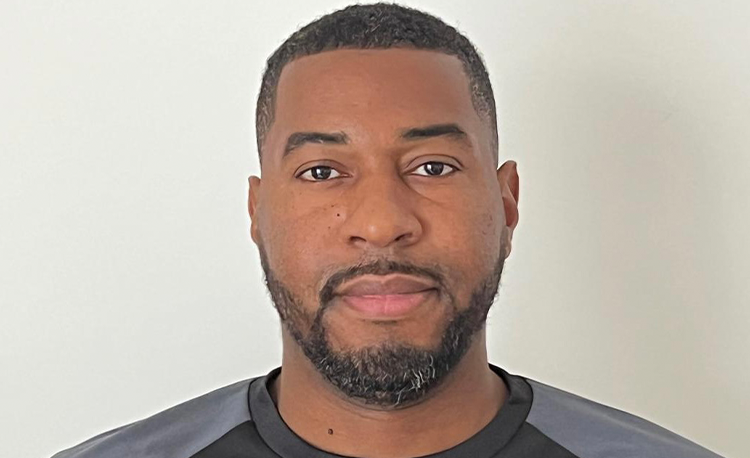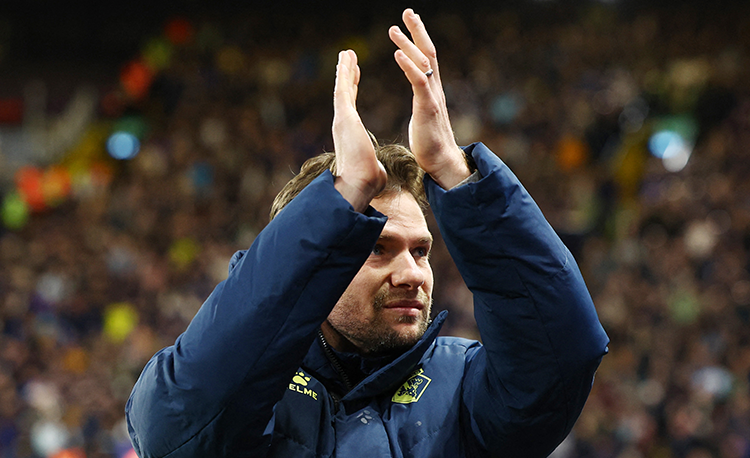Use the session to to perfect pressing from the front. It outlines technical and tactical ideas, and explains when is the best time to press, when players should be patient, resilient, and when hard to break down.

| Area | Up to a full pitch |
| Equipment | Balls, cones, goals, mini-goals |
| No. of Players | Up to 11v11 |
| Session Time | 95mins |
This session explains how we work with the team in order to perfect pressing from the front. It outlines technical and tactical ideas, and explains when is the best time to press, when players should be patient, resilient, and when hard to break down.
It’s a session that progresses from variable warm-ups to small-sided game situations and then a final 11v11 set-up, where we expect to see players practising all of the elements learnt in what is a plan that will test them both physically and mentally.
What do I get the players to do?
Warm-up
We set up as a 45x30-yard grid, with a five-yard zone at each end, as shown (1).
1
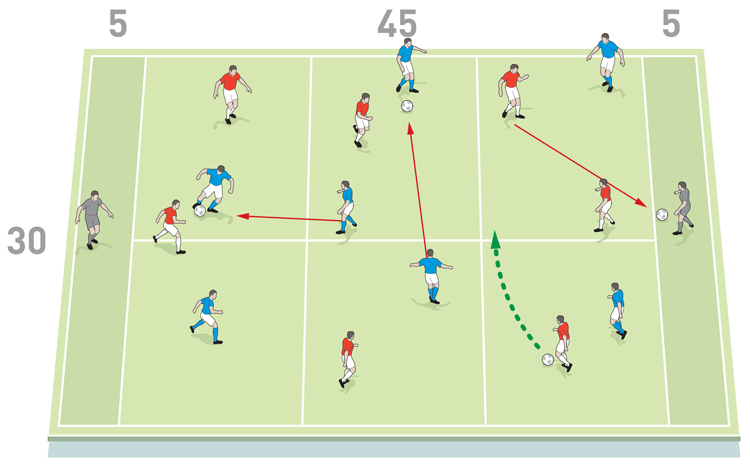
Within this there are seven reds, seven blues and two floaters. The warm-up is played out, as follows:
1) Two minutes with the ball
Four balls, two per team. Simply, players pass amongst themselves with floaters able to play with either team. We will encourage passing and dribbling with lots of touches.
2) Five minutes without the ball
Next it’s dynamic play and movement in the grid.
3) Three minutes with the ball at a higher tempo
Blues now pass to reds. Once a player has passed the ball they follow to put pressure on the player.
4) Two minutes without the ball
Still in the grid, these are short, sharp sprints. So four six-yard sprints then back to a jog; four jump headers, then turn and sprint six yards, then back to a jog; four four-yard sprints, then turn and sprint six yards; four 15-yard sprints with twists and turns.
5) Five minutes dynamic and static stretching
Game situations
We now work in the same area, 3v2 (red defenders versus blue attackers) in the first two boxes, 2v2 in the middle and 2v3 in the end, as shown (2a).
2a

2. Reds press as a unit
3. The red players move in – their first reaction is to try to prevent forward passes
4. The blue player receives and is closed down by red defenders
To score players must pass from one end zone to the other without the other team regaining possession. Once a team achieves this, the target man passes straight in to opposition and they try to score at the other end. The games evolve as follows:
Game 1 5mins, players must stay in their zones. Players in possession can use the target man to bounce the ball off. We’re looking for the defensive team to try to regain possession quickly, thinking about when it appears right to press, and when to drop and remain compact.
Game 2 5mins, players on the move. Once a pass is played into another zone, one of the players on the team in possession can move into that box (2b). Once possession is lost, the nearest player has to recover into the zone that has just been vacated. Defenders cannot track moving players out of their boxes.
2b
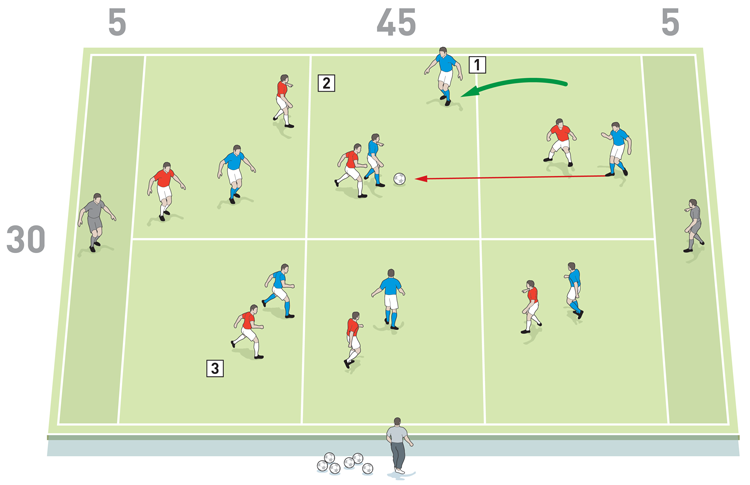
2. This spare red defender must be alert to the threat of the overload on his wing and close down accordingly
3. With the move coming back the other way defending reds must now sit back and be patient
Game 3 5mins, dribbling. All players can now dribble from one box to the next so we’re looking for defenders to make it hard for players in possession (3). Teams can still pass from zone to zone and are still looking for players to join in when the ball has been passed, but one defender can now track the runner and teams must focus on regaining shape when possession is lost.
3
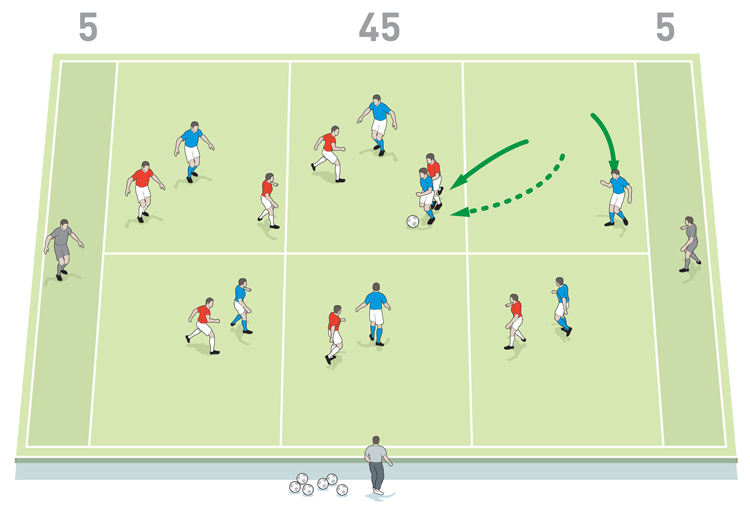
Game 4 5mins, free play. Players can now move anywhere on the pitch, but we’re still looking for teams to keep the correct shape, knowing when and where to press.
What are the key things to look out for?
Once the server passes the ball in to blues, we’re looking for reds to be patient, shuffling as a unit on side passes and trying to stop forward passes. The trigger to press is on any backward pass – the team presses as a unit to win the ball back. The other time to press hard is whenever the reds give away possession – and we will do this for six seconds. If defenders have not won the ball back after six seconds must sit back and be patient again.
Goal targets game
We now set up as shown on three-quarters of a pitch, with 11 reds in a diamond formation and 10 blues in a 4-3-3, as shown (4a). Blues attack the big goal but will only ever have eight active players on the pitch at any one time, and their back four all start in the end zone.
4a
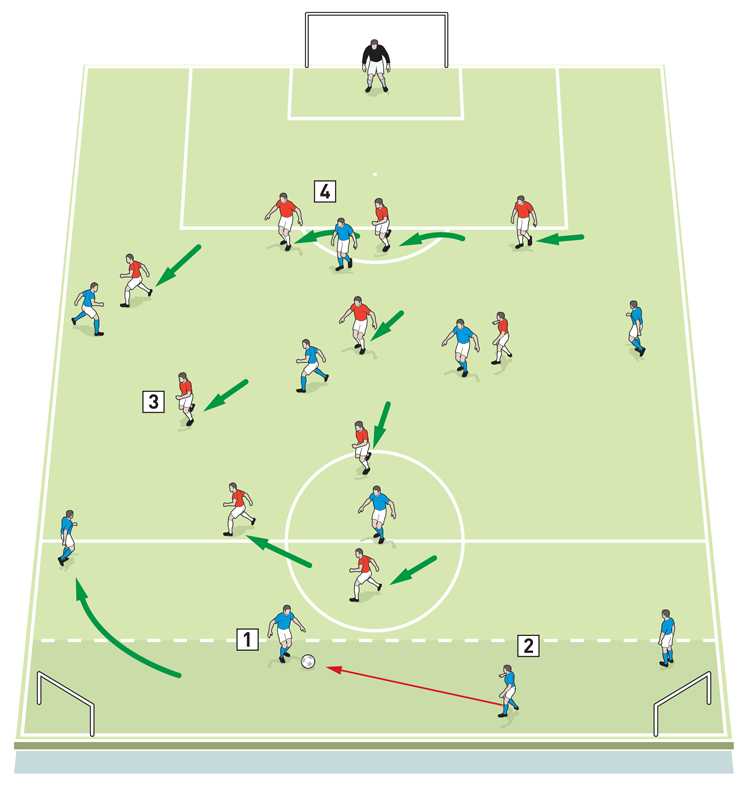
2. The right centre-back and right-back remain in the zone to start
3. Reds close in, pressing the men on the ball and looking to force play outside
4. Pressing players shift across to the side where play is concentrated
Reds must defend by keeping shape, knowing when to press and when to sit back. When they regain possession they can score into the mini-goals (4b). As soon as they score, the blue centre-back in the end zone quickly restarts play (to see how reds react when out of shape).
4b
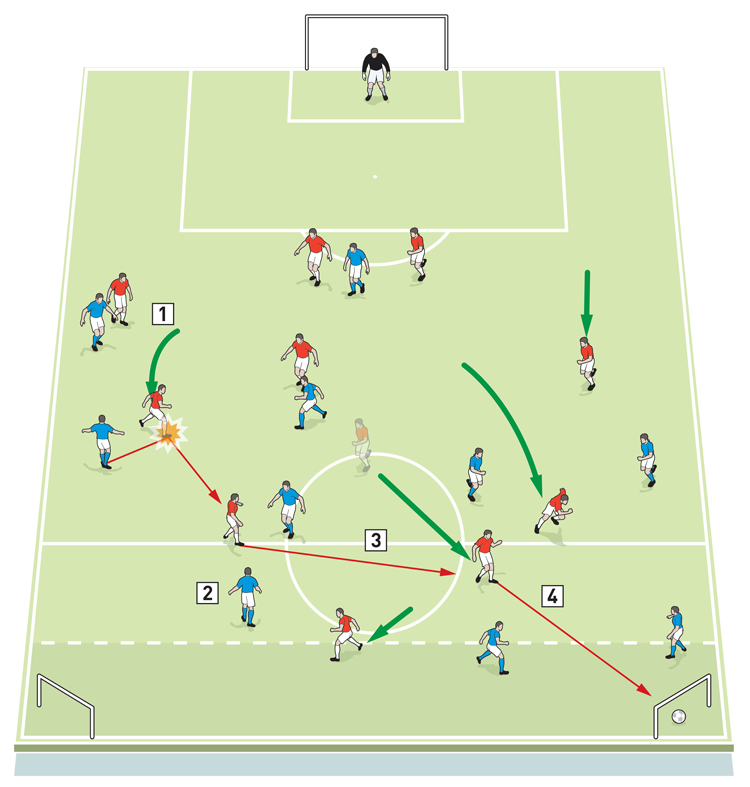
2. The left-sided centre-back is slow to react – he neither closes down the man on the ball nor retreats back into the zone
3. A diagonal pass is made
4. The red attacker scores
How do I put this into a game situation?
To finish, we move this into an 11v11. Reds adopt a diamond formation while blues play 4-3-3. Putting all that’s been practised together we want to see players using good body shape, speed of approach and recovery runs whilst adopting a low centre of gravity when 1v1. Tactically, they need to know when and where to press, with an eye on forcing play outside and maintaining distances between defenders. They also need to fill in for team mates, press as a unit and communicate well, staying compact and disciplined.
Editor's Picks
Attacking transitions
Deep runs in the final third
Using the goalkeeper in build-up play
Intensive boxes drill with goals
Penetrating the final third
Creating and finishing
My philosophy
Pressing initiation
Compact team movement
Coaches' Testimonials
Coaches' Testimonials
Join the world's leading coaches and managers and discover for yourself one of the best kept secrets in coaching. No other training tool on the planet is written or read by the calibre of names you’ll find in Elite Soccer.
In a recent survey 92% of subscribers said Elite Soccer makes them more confident, 89% said it makes them a more effective coach and 91% said it makes them more inspired.
Get Monthly Inspiration
All the latest techniques and approaches
Since 2010 Elite Soccer has given subscribers exclusive insight into the training ground practices of the world’s best coaches. Published in partnership with the League Managers Association we have unparalleled access to the leading lights in the English leagues, as well as a host of international managers.
Elite Soccer exclusively features sessions written by the coaches themselves. There are no observed sessions and no sessions “in the style of”, just first-hand advice delivered direct to you from the coach.















